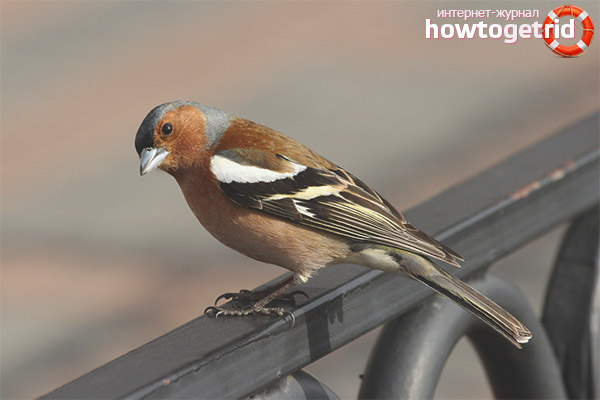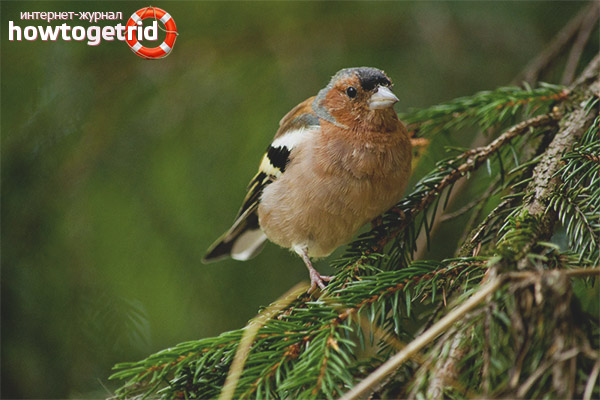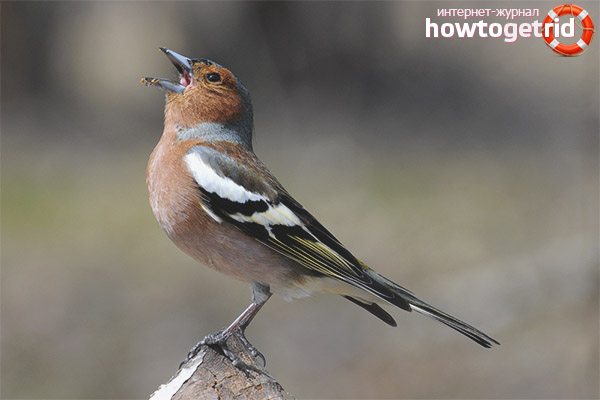The content of the article
Chaffinch is a very attractive-looking songbird. It belongs to the family finch, which has many species of birds. They live in Europe, Asia. They can be found even in northern Africa.
general description
The bird gave the name to the people. So it is called almost everywhere. The female is sometimes called the finch. In some areas, a bird is also called a yurok or a cast-iron.
Adult birds are small, like all passerines. The body length of the bird can reach a little more than 14 cm. Their wingspan on average is 25-28 cm. The weight of the bird is from 20 to 40 g.
- They have an elongated and sharp beak.
- Tail with pronounced notch.
- The plumage is dense and quite soft. The color is bright.
- Males have a bluish gray and gray head and neck. Their forehead is painted black. The plumage is brownish on the back. In the lumbar region it is yellow-green.
- Interestingly, during the mating season, the male’s beak becomes bluish, and in the remaining months it is brownish pink.
- The wings of the birds are brown. The lower part of the body is painted in a pale brown color.
- Females are gray-brown below, and painted brown above. Young finches have virtually no sex differences. Plumage changes only with age.
Lifestyle
In the fall, they fly away to winter in warmer areas. This is not happening at the same time either. Departure lasts from the very beginning of autumn to the middle. They fly away, gathering in relatively numerous flocks. They number up to several hundred birds. During the flight, flocks of finches sometimes stop to rest and find food for themselves. At this time, they can be seen in the North Caucasus.
There are many subspecies of finches. They differ in size, color, length of the beak, as well as various features of behavior.
The life span of these birds is short. Individuals that live in the wild can live only a few years. This is due to the fact that in modern conditions they are affected by many unfavorable factors. In captivity, they are able to live much longer. Cases were recorded when finches lived for 10-12 years. But for this, the bird must be looked after. Although this species is notable for its unpretentiousness.
Habitat
This species lives on the territory of Europe, as well as in the western regions of Asia. On the African continent, they live only in the northwestern regions. They can be seen in some regions of Norway and Sweden. They also live in the British Isles.
A lot of these birds live almost throughout the CIS. Some birds fly away to winter on the Caspian Sea. At that time they can be seen here on the northeast coast. They also fly to Iceland and even to the Faroe Islands.
Representatives of this species live in various places. It is very important for these little birds that any woody vegetation is present where they live.
Very often they live in cultivated tree zones. For example, in gardens, groves, on boulevards and in parks. Often these birds can be seen at the edges of the forest. They live in both deciduous and coniferous forests. They prefer sparse forest zones, as well as island ones, which are located in the middle of the steppe.
These birds are one of the most numerous among those species that live on the territory of Russia. They can often be seen in city parks. They often settle very close to a person.
Nutrition
The diet of these birds contains mainly various insects. Studies have been conducted to study the nutrition of finches. Scientists came to the conclusion that they feed not only on insects, but also on weed grass seeds, fruits, and berries.
But in the period from April to autumn, animal food predominates in their diet. Most often they eat small beetles, they are very fond of weevils. Therefore, representatives of this species of birds bring a lot of benefits to humans. After all, they destroy so many harmful insects that are pests of agriculture and forestry.
Enemies in nature
Representatives of the species are quite unpretentious to the living conditions of birds. They can live in a variety of conditions and are distinguished by their endurance. But their numbers today are affected by various factors. These are the climatic conditions of the terrain in which they live. In addition, during the nesting period, these birds and their nests are often attacked by other birds and animals. Sometimes a woodpecker attacks the nest. But most often nests are destroyed by other birds - jays, crows, owls. Among mammals, their enemies are ermines and squirrels.
Breeding and nesting
From the places of wintering, these birds fly in packs, which consist of representatives of the same sex. Males arrive to the nesting places a little earlier. When the breeding season begins, the males emit peculiar screams. These sounds are somewhat reminiscent of the squeak of chicks. They alternate with singing.
During mating, males, as a rule, fly from place to place, often sing, and also constantly fight among themselves. The true tolling, which is characteristic of many other species of birds, is completely absent in finches. Mating takes place on the ground or on powerful branches.
These birds begin to build a nest only a month after arrival. In many areas where climatic conditions allow, these birds can lay eggs more than once per season.
The female builds a nest. But the male also plays a significant role in this. After all, he searches and brings her all the material. These birds build a nest from various thin branches, as well as the roots and stems of plants. Constructed, it looks like a ball with a vertex cut off. Finches tend to mask their nest so that it is as small as possible visible to enemies. After all, as already mentioned, birds of prey and mammals often attack him. To make it as less noticeable on a tree as possible, finches cover the outer surface with moss and birch bark.
The eggs of these birds are usually colored green with a bluish or reddish hue. They are covered with rather large spots of a pinkish tint. In one clutch there are usually from 4 to 7 eggs. Only female incubates. Chicks appear rather quickly. This usually occurs after about 2 weeks.
Both mother and father bring food to the chicks. They find various invertebrates for them. Chicks eat caterpillars, spiders and the larvae of some insects. Concern for offspring does not last long either. Parents feed their chicks for about 2 weeks. After that, they begin to live independently. And the female begins to prepare for the next laying. To do this, she is building a new nest.
Status and Population
The territories that are suitable for nesting of this bird are becoming smaller. This leads to the fact that their distribution does not increase, but decreases. In some areas, the view simply disappears.
But, despite these difficulties, the abundance of the species is very large. In Europe alone, there are about 100 million pairs of finches. In addition, a lot of them also live in Asia. Although finches are numerous, their habitat must still be protected. After all, this small bird brings a lot of benefits to humans, destroying pests.
Video: finch (Fringilla coelebs)












Submit